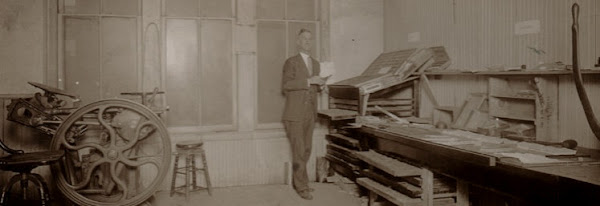Well, it's been one of those months when not much has gotten done around the shop in terms of printing, my day job has been extremely stressful and tiring, and so finding a real need to relax I helped some friends move thousands of pounds of iron, wood, and lead. Oh, yeah.
The first such adventure was helping my friend Sarah Smith of Smith Letterpress move her recently acquired C&P 8x12 press, a Challenge paper cutter, imposing stone and bench, and misc. items from Alan
Runfeldt's Excelsior Press in
Frenchtown, NJ to Long Island on a Saturday the second week in June.
Interestingly enough, this paarticular press was my first press which, as readers of this blog may remember, I traded for a 10x15 last Fall. I can't say how happy I am that Sarah now has this press.
The day started out fine as we used a small U-Haul box truck with a pullout ramp to move everything. It looked like we might avoid the rain but no, after traversing the Lincoln Tunnel, Manhattan, and Queens, we ran into some wetness just before arriving on the north shore of the "Big Island". It was then we found out that the layout was not quite what we had thought and the truck had to be parked somewhat further away from the storm cellar entrance than we had anticipated. But we had come well prepared with plywood and 2x6's and as you will see from the photos. Good thing we had recently watched Bridge on the River
Kwai.
Photos are posted here:
http://picasaweb.google.com/funkedude/PressMove?feat=directlinkWhen all was safely in the basement we were treated by Sarah's very gracious, easy-going and
companionable parents to massive, juicy, marinated and delicious
BBQ'd steaks and accessories. I took advantage of an offer by Sarah's mom and took an outdoor shower that was extremely refreshing. We
sweated and we grunted and we ate, and then we had a long drive back home. All in all it was a very satisfying and enjoyable adventure.
Adventure No. 2 started on Friday morning the 24th about 9:30 and ended Saturday morning about 5:15. The mission was to travel to Clinton, Conn. and
retrieve a Heidelberg platen press, a Golding jobber, a paper cutter, cabinets of type and galleys, and misc. treasures. The shop was once owned and run out of the basement of Alan Duran who began printing privately about 30 years ago. He recently passed away and the house is being sold. His son and grandson wanted his equipment to go to people who would preserve and use it and carry on Mr. Duran's legacy. They contacted my friend Alan
Runfeldt of the Excelsior Press who in turn found a man in West Virginia looking for a Heidelberg. It was arranged that he would come up with a trailer and pick Alan and I up and then
continue on to Conn. where we would pick up the equipment. We would
stop back at Alan's shop and unload everything but the Heidelberg which would continue on to its new home father south. Alan will make the other equipment available for sale to help
others building their shops and provide funds for his Excelsior Press museum.
Here are photos of that move:
http://www.flickr.com/photos/shawfamilypublishing/sets/72157620540304943/Fortunately the shop was in a basement that was at garage level and we only had to demolish a short section of wall to make room to get everything out. The wall was somewhat makeshift and will be easy to replace if necessary. Once again there was plenty of rain and we just missed a tornado. But though extremely tiring and taking nearly 24 hours from start to finish, it turned out well and we all have a few more things for our shops and to pass on to others. Mr. Duran's family was very personable, only to be expected of members of a Bluegrass band of course, and provided labor, coffee, pizza, and plenty of moral support. I even got a vintage oscillating fan from the garage sale pile for my shop!
All in all it was an eventful month even it it did keep me out of the shop. Now it's on to pending projects.















































